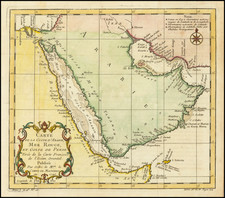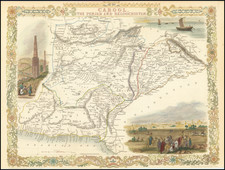A Map of the Travels of Wilfred Thesiger (and accompany essay).
Interesting map of a portion of Saudi Arabia, published to illustrate a journal article by W. Thesiger in the Journal of the Royal Geographical Society.
The map provides a meticulous accounting of Thesiger's travels, topographical information, swells, springs, place names, etc. He also provides lists of Tribal names.
Sothebys describes the map as follows:
The rarest of Thesiger’s maps. After his appointment to the Anti-Locust Unit, he flew into Jeddah and . . . made a short exploratory trip around Saudi in four wheeled vehicle. In Jeddah he met Harry St John Bridger Philby for the first time. He made a quick visit to the Tihama; then “lured by tantalizing glimpse of a lovely race”, returns in April/June 1946 to travel 950 miles around the coastal region between the mountains and the sea, very African in flavour and stretching most of the length of the Red Sea. He climbs on the path of an old trade route, to the mountainous area of the Asir, to Abha where there is the highest peak in Saudi; and travels along the spine of the mountains to Taif, a kind of old summer “capital”, a retreat from the hot coastal region around Jeddah. (A tarmac road is not built between Abha and Taif until the mid-1980’s.) The opening sentences of his famous book, “Arabian Sands” describing all his desert travels around the Empty Quarter 1945-1950, are set in the Asir mountains and he is looking out over the distant desert.
Wilfred Thesiger
Sir Wilfred Patrick Thesiger (1910 – 2003), also known by his Arabic name Mubarak bin London, was a British military officer, explorer, and writer. Thesiger's travel books include Arabian Sands (1959), on his foot and camel crossing of the Empty Quarter of the Arabian Peninsula, and The Marsh Arabs (1964), on his time living with the Marsh Arabs of Iraq.
In 1930, Thesiger returned to Africa at the invitation from Emperor Haile Selassie to attend his coronation, and joined the Order of the Star of Ethiopia. He returned again in 1933 as the leader of an expedition, funded in part by the Royal Geographical Society, to explore the course of the Awash River. During this expedition, he became one of the first Europeans to enter the Aussa Sultanate and visit Lake Abbe.
Between 1935 and 1940, Thesiger served with the Sudan Political Service, stationed in Darfur and the Upper Nile. At the start of WWII, Thesiger joined the Sudan Defense Force, helping to organize resistance to the occupying Italians. He later served with the Special Operations Executive in Syria and the Special Air Service during the North African Campaign, attaining the rank of Major. From 1943 to 1945 he acted as political adviser to Crown Prince Asfa Wossen of Ethiopia.
After the War, Thesiger travelled across Arabia, lived for some years in the marshes of Iraq, and then travelled in Iran, Kurdistan, French West Africa and Pakistan. He lived for many years in northern Kenya.
Thesiger in Arabia
He is remembered for his Arabian expeditions. In 1945, an entomologist, O.B. Lean, acting on behalf of the Middle East Anti Locust Unit (MEALU), hired Thesiger to search for locust breeding grounds in southern Arabia. This led to two crossings of the great Arabian desert, the Rub' al Khali or Empty Quarter, and travels in inner Oman. He rode camels in the company of Bedu guides through remote areas that were potentially dangerous on account of tribal tensions and the opposition of local rulers to the presence of foreigners.
Thesiger's first crossing began in October 1946 when, with his Bedouin companions, he left Salalah in the Dhofar province of Oman and travelled to the Mughshin Oasis. From there, he entered the sands but there was dissent among his party, some of whom were unwilling to travel any farther. Thesiger continued with four members, two from the Rashid and two from the Bait Kathir tribes. He reached the Liwa Oasis in the Emirate of Abu Dhabi in mid-December, visited the town of Abu Dhabi, then crossed into Oman, heading back towards Salalah via Dhofar and ending his journey at Salalah on 23 February 1947.
His second crossing began in December 1947, at Manwakh well in Yemen. The king of Saudi Arabia did not agree to Thesiger entering his territory, and imprisoned Thesiger and his party when they arrived at Sulayil. Soon released, they travelled to the Liwa Oasis and then to Abu Dhabi town, arriving on March 14,1948. In April, Thesiger visited the Buraimi Oasis, for which the Iraq Petroleum Company (IPC) held an oil concession, which it operated through an associate company, Petroleum Development Oman. Dick Bird, the company's representative, was concerned by Thesiger's attitude towards oil exploration. Thesiger disapproved of the company's activities, believing that the discovery of oil would destroy the Bedouin way of life. However, the need to finance his expeditions led the explorer to accept funding from the oil company in exchange for providing information garnered from his travels.
Thesiger returned to England in the 1990s and was knighted in 1995.











![[Middle East, Central Asia & Indian Ocean]](https://storage.googleapis.com/raremaps/img/small/92812.jpg)
![[Sidon, Lebanon] Plan de Seide en Syrie](https://storage.googleapis.com/raremaps/img/small/61410.jpg)

![(Second World War - Oilfields) Vorderasien mit seinen Erdölgebieten [Western Asia with Its Oil Fields]](https://storage.googleapis.com/raremaps/img/small/87373.jpg)

![[Ottoman map of the Arabian Peninsula]](https://storage.googleapis.com/raremaps/img/small/99778.jpg)